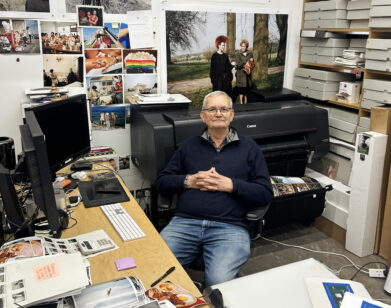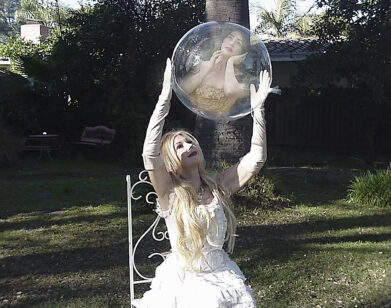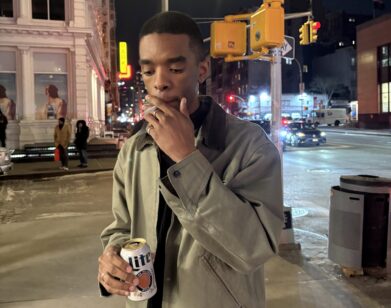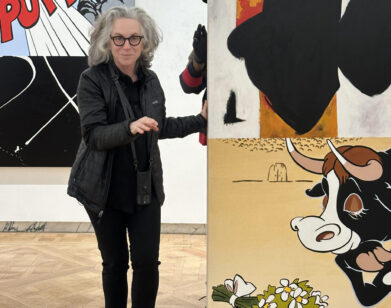Mika Tajima’s Intangible Tangibility
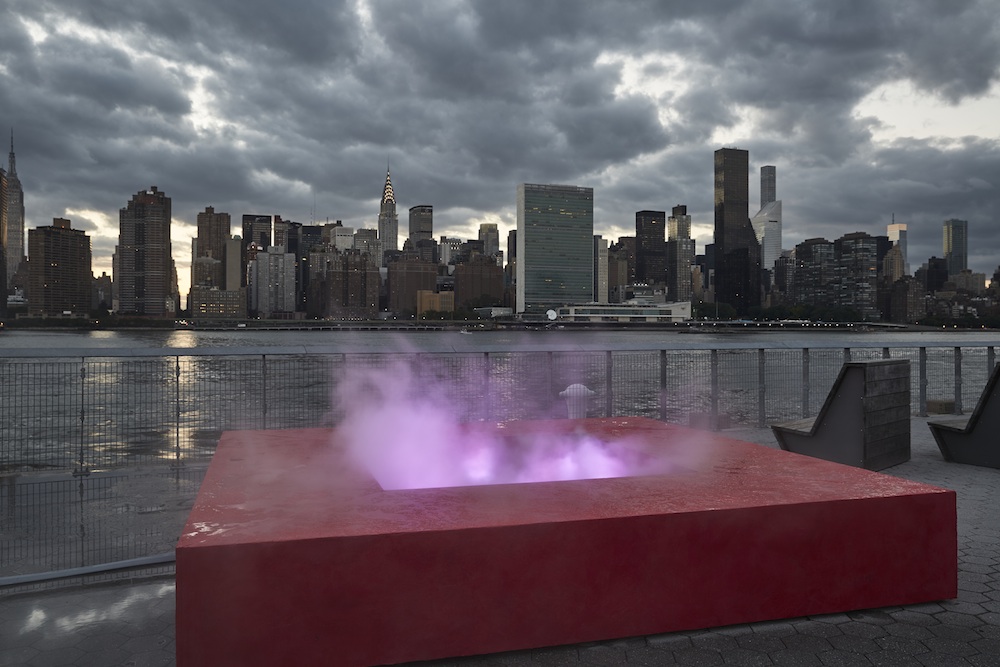
Resting on the edge of the East River in Long Island City’s Hunter’s Point Park South is a hot pink, Jacuzzi-like structure. From the park’s opening to its close, plumes of a cooling mist rise from the sculpture’s teak wood center. LED lights illuminate the clouds of vapor, allowing the opaque form to appear in hues ranging from magenta to cyan, the color fluctuating directly in accordance with the commodity price of gold. Aptly, the public sculpture, designed by artist Mika Tajima, is titled Meridian (Gold).
The project, presented by SculptureCenter, is a continuation of Tajima’s recent mood light sculptures, which rely upon the integration of technology. For Meridian (Gold), Tajima worked with a developer to design a program that tracks the percentage increase or decrease of gold’s value (you can watch it change via a digital marquee here); the LED lights adjust themselves accordingly. In other mood light sculptures, Tajima scrapes Twitter to determine the overall feeling of a city’s inhabitants. For example, in Istanbul, she is currently exhibiting light sculptures that respond to the aggregated sentiment of those living in New Songdo City, South Korea.
Tajima, who was born in Los Angeles and is now based in New York, often focuses on the interplay between transient technology and tangible objects. While gold is a physical object, its commodity price is controlled by external sentiments, such as the geopolitical climate. Before the public unveiling of the sculpture, we met Tajima to learn more about the process.
EMILY MCDERMOTT: SculptureCenter is presenting project, but it was commissioned as part of Public Process, a program for New York City high school students. Can you tell me what that process was like?
MIKA TAJIMA: The students were very engaged. They came to my studio and I showed them examples of my work. Then I showed them the presentation of the proposal, spoke in depth about the reasons for my choices and concept, and then they went off and had their internal debate. I think it came down to me and one other artist. It’s impressive, because it’s pretty risky and conceptual to be like, ‘Let’s have a public art piece that’s ephemeral and changing and uses technology as the core of the project.’ It’s not about an object itself, the core of the piece is not there. It’s hard to get your head around something that’s not a monument.
MCDERMOTT: I’m curious as to how the color is changing in relation to the price of gold, as well as what drew you toward using gold in the first place.
TAJIMA: The lights are networked LED bulbs. They’re hooked up to the internet. I work with a linguistics programmer to create a custom sentiment analysis program. I’m scraping five different indexes around the world for gold commodity price, the percentage change, and fluctuation of the price. I arrived at gold as the item to track because it’s unusual; it actually is an indicator for people’s mood or sentiment. In the last two days, gold has been the highest price that it’s been the last two years because of various things happening: The Labor Department’s job market report came out, it’s looking really bad, and that decided not to raise interest rates, so it’s a low point, or people are concerned.
Gold has traditionally been this place that people think of as a safe haven or with some kind of stability as a material, but that is a myth. It fluctuates with any geopolitical or economic or financial event that’s going on. It’s never the same, never stable. While there is material there—gold as a concrete object—it’s more about the information and commodity idea [surrounding it]. It’s a hard, tangible item, but the price of it is intangible. It’s not like, “Oh, somebody found a gold mine, there’s tons more gold out there,” and the price of gold suddenly changes. There is no connection.
Gold is really about how people feel, so I wanted to use that as the thing that reflects our time—the way that technology and information architecture is trying to quantify our lives, to understand human emotion, and try to figure out how to tap into things that are typically unquantifiable. Over the past few years, the different things I’ve been interrogating are architecture, design, and technology—things that shape our lives and literally shape our bodies and activities. So I’ve done [pieces with] different things that are both objects and locations.
MCDERMOTT: Like your Jacuzzi paintings?
TAJIMA: Yeah, [the Jacuzzi] is both an object and social space. The way that I arrived at doing the mood light pieces is that lighting is an integral architectural device but isn’t often a foregrounded element. People aren’t usually noticing the lighting, but it tells you what type of space [it is] and what type of feeling that space gives you. I started thinking about that and how the feeling and affect of a space changes because of the way it’s lit. Going into H&M, it’s really bright halogens, but going into a gallery like Paula Cooper, it’s warm daylight. So I started thinking about connecting those two elements: light as an architectural device and how we feel in a space. Then I started also thinking about how technology is attempting this kind of control and quantification and commodification of our lives.
I’m lucky because one of my oldest friends is a computational linguistics academic and he has worked with me in integrating sentiment analysis programming with LED light technology to visualize data into light color. These days, because of a variety of bad news and general unrest in the world, we see that gold is on an upward trend—towards pink. As for the color choices, I tried to choose LEDs that were a little bit stranger, a little bit off the usual spectrum. Also, knowing that because the price is moving, the color will always be a blend between the two ends.
MCDERMOTT: Did you consider any other currency? With so much thinking about technology, the immediate and obvious thought is bitcoin.
TAJIMA: I was looking into it, but I liked that gold is a tangible thing and also an idea, versus something that’s a complete invention. I liked the idea that it’s these two things, both material and immaterial. It’s a very symbolic item. You say, “What is the gold standard? There are so many connotations to that word. I did research to see if there were other similar commodities, but this one really has that twist of poetics.
MCDERMOTT: Can you tell me what else are you working on at the moment?
TAJIMA: I’m in the Gwangju Biennale, which is coming up in September. I’ll be showing three different mood lights there, along with woven acoustic portraits from a series that I’ve been doing. I also have a show up right now at Protocinema in Instanbul, which is a counterpoint to Gwangju.
MCDERMOTT: What is it like scraping information? Is it a program that’s constantly running or something that you aggregate at a certain period or intervals? I can’t really imagine what that looks like.
TAJIMA: It’s in real-time and going 24 hours a day. I leave it running, I host the program on a private page on my website. Because the Istanbul project is going on, I also have a set of lights that I have on in my house. That way I can monitor the movement of lights and if I notice something weird, I look at my laptop—what’s going on?
MCDERMOTT: That’s an interesting way of receiving news, “Oh, the lights have changed, what’s happening?”
TAJIMA: [laughs] Totally. My first light sculptures using this technology were for a show in Tokyo last October. The developer and I have been working on the program for a year and half or two years now. The sentiment analysis program is a natural language learning program; it learns over time, keeps adding to the vocabulary. For Istanbul, we added Turkish to the language database for it to learn. It’s taking in English, Turkish, Arabic, German, French, all these languages. We’re constantly adding and adapting and building it up. Korean was the last addition.
MCDERMOTT: How many languages do you speak?
TAJIMA: I only speak two, English and Japanese.
MCDERMOTT: Well, it’s a very impressive program.
TAJIMA: Yeah, and the thing about this piece is that it’s all about action and technology and infrastructure. The physical object was not hard at all; the hard part was the configuring the technology behind it, integrating the lights with the fog.
MCDERMOTT: So when a stranger comes up to the piece, what do you hope that they will take away from it?
TAJIMA: To think about what the possibilities are outside of being quantified and commoditized, maybe take a moment to sit and not think about being hooked in—how can we escape our daily life? Also to be very aware of the multiple contradictions of technology in our daily lives, going back to this idea of gold as a tangible object that’s also this abstracted, tethered thing. As much as we live in the “virtual world,” we’re still here in our bodies.
MERIDIAN (GOLD) WILL BE ON VIEW AT HUNTER’S POINT SOUTH PARK IN LONG ISLAND CITY THROUGH SEPTEMBER 25, 2016. FOR MORE ON THE ARTIST, VISIT HER WEBSITE.

